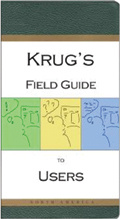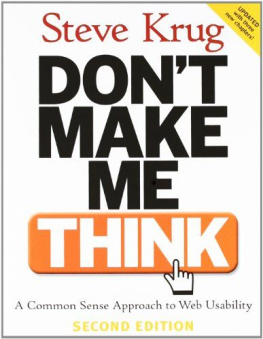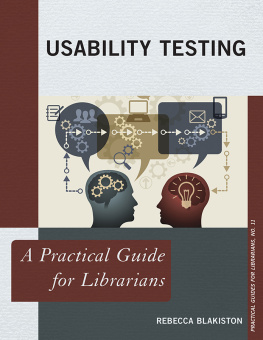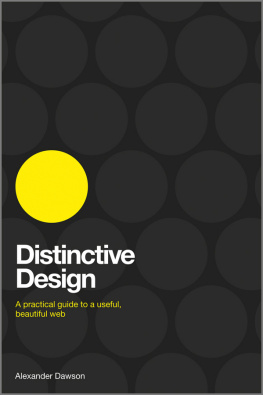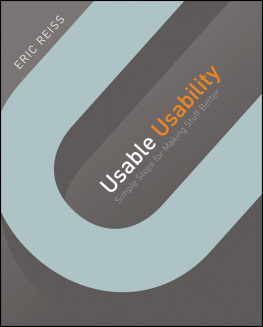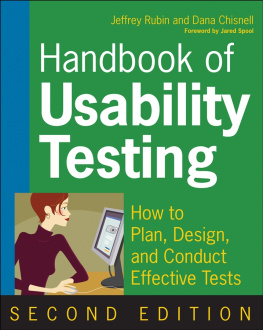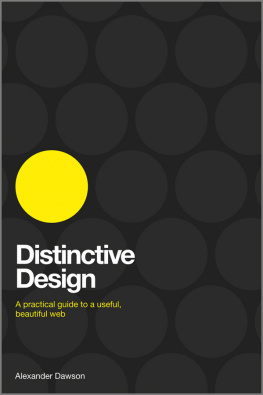Dont Make Me Think!
A Common Sense Approach to Web Usability
Second Edition
Steve Krug

New Riders Publishing
Berkeley, California USA
Dont Make Me Think! A Common Sense Approach to Web Usability, Second Edition
2006 Steve Krug
New Riders
1249 Eighth Street
Berkeley, CA 94710
510/524-2178
800/283-9444
510/524-2221 (fax)
Find us on the Web at www.peachpit.com
To report errors, please send a note to
New Riders is an imprint of Peachpit, a division of Pearson Education.
Editor: Karen Whitehouse
Production Editor: Lisa Brazieal
Interior Design and Composition: Allison D. Cecil
Illustrations by Mark Matcho
Farnham fonts provided by The Font Bureau, Inc. (www.fontbureau.com)
Notice of Rights
All rights reserved. No part of this book may be reproduced or transmitted in any form by any means, electronic, mechanical, photocopying, recording, or otherwise, without the prior written permission of the publisher. For information on getting permission for reprints and excerpts, contact .
Notice of Liability
The information in this book is distributed on an As Is basis, without warranty. While every precaution has been taken in the preparation of the book, neither the author nor Peachpit shall have any liability to any person or entity with respect to any loss or damage caused or alleged to be caused directly or indirectly by the instructions contained in this book or by the computer software and hardware products described in it.
Trademarks
Throughout this book, trademarks are used. Rather than put a trademark symbol in every occurrence of a trademarked name, we state that we are using the names in an editorial fashion only and to the benefit of the trademark owner with no intention of infringement of the trademark. No such use, or the use of any trade name is intended to convey endorsement or other affiliation with this book.
ISBN 0-321-34475-8
9
Printed and bound in the United States of America
FIRST EDITION
To my father, who always
wanted me to write a book,
My mother, who always
made me feel like I could,
Melanie, who married methe
greatest stroke of good fortune of my life,
and my son Harry, who will surely
write books much better than this one
whenever he wants to.
SECOND EDITION
To my big brother, Phil,
who was a mensch his whole life.

CONTENTS
GUIDING PRINCIPLES
THINGS YOU NEED TO GET RIGHT
MAKING SURE YOU GOT THEM RIGHT
LARGER CONCERNS AND OUTSIDE INFLUENCES
PREFACE
About the Second Edition
Just when I thought I was out, they pull me back in.
MICHAEL CORLEONE, IN THE GODFATHER, PART III
Since Dont Make Me Think was first published nearly five years ago, people have been wonderful about the book.
I get lots of lovely email. You cant imagine how nice it is to start your morning with someone youve never met telling you that they enjoyed something that you did. (I recommend it highly.)
Even nicer is the fact that people seem to like the book for the same reasons I do.
For instance:
> Many people appreciate the fact that its short. (Some have told me that they actually read it on a plane ride, which was one of my stated objectives for the first edition; the record for fastest read seems to be about two hours.)
> A gratifying number of people have said that they liked the book because it practices what it preaches, in the writing and the design.
> Some people said it made them laugh out loud, which I really appreciated. (One reader said that I made her laugh so hard that milk came out of her nose. How can something like that help but make you feel that your time has been well spent?)
But the most satisfying thing has been people saying that it helped them get their job done better.
But what have you done for us lately?
It only took about a year after the book appeared for people to start asking me when I was going to do a second edition.
For a long time, I really resisted the idea. I liked the book the way it was and thought it worked well, and since it was about design principles and not technology, I didnt think it was likely to be out of date anytime soon.
Usually Id pull the consultant/therapist trick of asking them what they would change, and the answer was almost always, Well, I guess you could update the examples. Some people would point out that some of the sites in the examples didnt even exist anymore.
But the fact is, many of the sites in the book were already gone by the time it hit the bookstores. (Remember, it came out right before the Internet bubble burst.) The fact that the sites werent around didnt make the examples any less clear.
Other people would say, Well, you could talk about the things about the Web that have changed. Its true; some things about the Web have changed in the last few years. Some of the changes were good:
> More good sites to copy from
> Cascading Style Sheets (CSS) that actually work
> Useful conventions like printer-friendly pages and Amazon.coms Whats this?
> Google as the starting point for all actions
> The swing in business models from banner ads (for things I dont want) to Google ads (for things I actually might want)
> Hardly anyone uses frames anymore
and some not so good:
> Pop-ups
> Phishing
But these changes didnt make me feel a need to update the book, which is about design principles, not specifics of technology or implementation.
And there was one other problem: I was very proud of how short the book was. It took a lot of work, but it was an important part of the practices what it preaches business. If I was going to add any new material, Id have to throw some of the existing stuff overboard, and I thought it all worked pretty well.
So, what are we doing here?
One of the nicest fringe benefits of the book for me is that Ive been able to spend time teaching workshops.
In the workshops, I try to do the same thing I did in the book: show people what I think about when I do a usability review of a Web site.
And since everyone who comes to the workshops has already read the book, naturally I had to come up with different examples to make the same points, and different ways of explaining the same things. I also get to do a lot of reviews of different kinds of sites, because everyone who comes to the workshop can submit a URL, and during the day I do 12-minute expert mini-reviews of some of them, and a live user test of one or two others.
And as anyone whos ever taught anything knows, teaching something is the best way to learn more about it.
So when my publisher started asking about a second edition again last year, I actually thought about what a second edition might be like. And while I still felt there wasnt much Id change or delete from the first edition, I realized I did have some other things I could write about that might be helpful.
Like what?
The new material mostly falls into three categories:


